Blog
The fastest whales and dolphins in the ocean
Read more20 of the most fascinating animals in Asia
From the peaks of the Himalayas to the tropical rainforests of Southeast Asia and the Siberian taiga, the Asian continent holds vast biodiversity of plant and animal life. These are 20 of the most interesting and unique animals you will find in Asia, selected by IFAW staff.
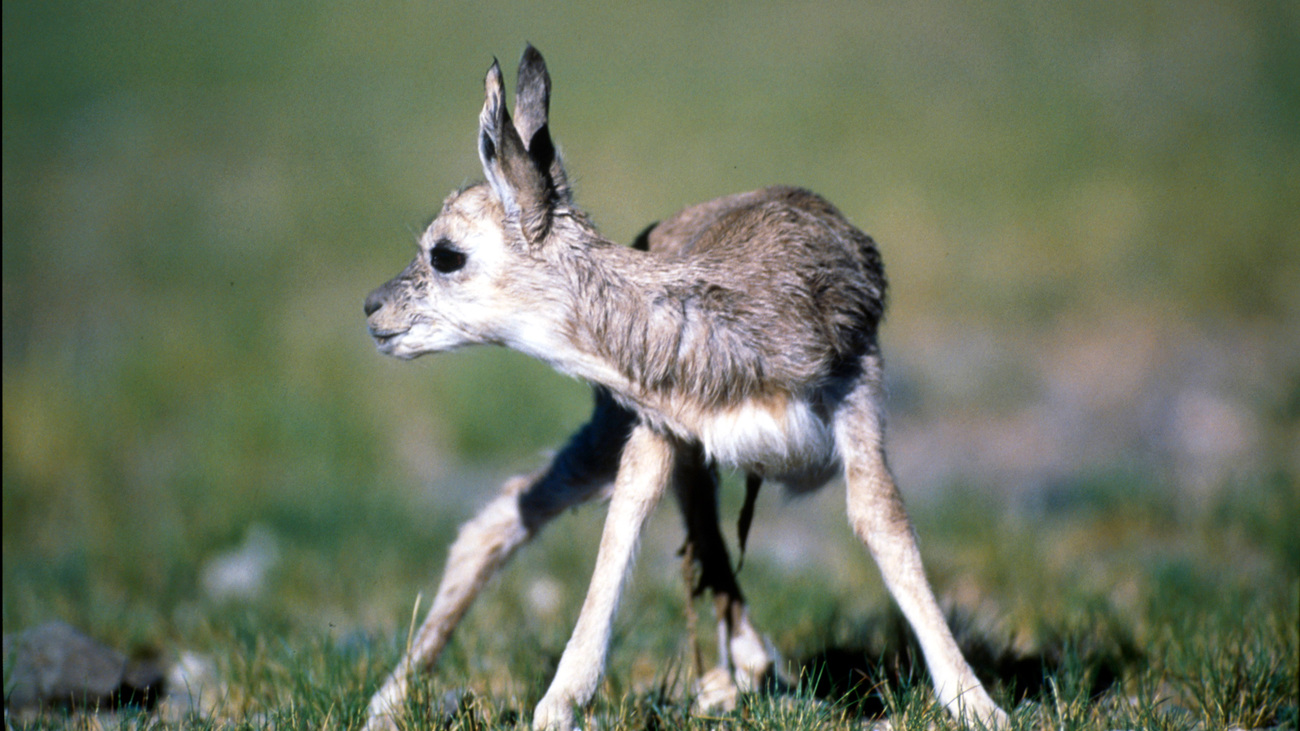
The Tibetan antelope (Pantholops hodgsonii), also known as the chiru, is a medium-sized mammal of the Bovidae family that lives in the northeast of the Tibetan plateau. Tibetan antelopes have thick, wooly, reddish-brown coats with white bellies and black fur on their faces. Male Tibetan antelopes have long, slender, slightly curved horns. However, sadly Tibetan antelopes were poached in large numbers in the 1980s and 1990s for their underfur, which is called shahtoosh.
In 1999 IFAW helped the government of China to draft the Resolution Conf. 11.8 (Rev. CoP17) on the Conservation of and control of trade in the Tibetan antelope, which was accepted by all CITES parties. And through IFAW’s advocacy, in 2006, the US government listed the Tibetan antelope under the Endangered Species Act, completely banning the domestic trade of shahtoosh shawls within the United States. Since the 1990s, hunting and trade are strictly forbidden, and the population of Tibetan antelopes has surged from 50,000 to more than 300,000 over the past decades. Though they were considered endangered in 2008, Tibetan antelopes are now listed by the IUCN as near threatened.
The king cobra (Ophiophagus hannah) is a venomous snake native to parts of China, India, Central Asia, and Southeast Asia. It can grow up to 4 metres (13 feet) long and is known to ‘stand up’ by lifting a third of its body off the ground. Its venom is powerful enough to kill 20 humans with a single bite—but fortunately, king cobras are shy and avoid humans when possible. They primarily eat other snakes, also feeding on lizards, eggs, and small mammals. King cobras are the only snakes that build nests for their eggs. The king cobra is listed as vulnerable.
Draco is a genus of lizard consisting of 41 different species known as flying lizards, gliding lizards, or flying dragons. They are so named because they have membranes connected to very long ribs that can be extended to function as wings. While not capable of powered flight (i.e., taking off from the ground), they can glide from tree to tree, travelling for extended distances without losing much height. These lizards primarily inhabit rainforests of India and Southeast Asia. While most species of flying lizards are listed as least concern, two are considered near threatened.
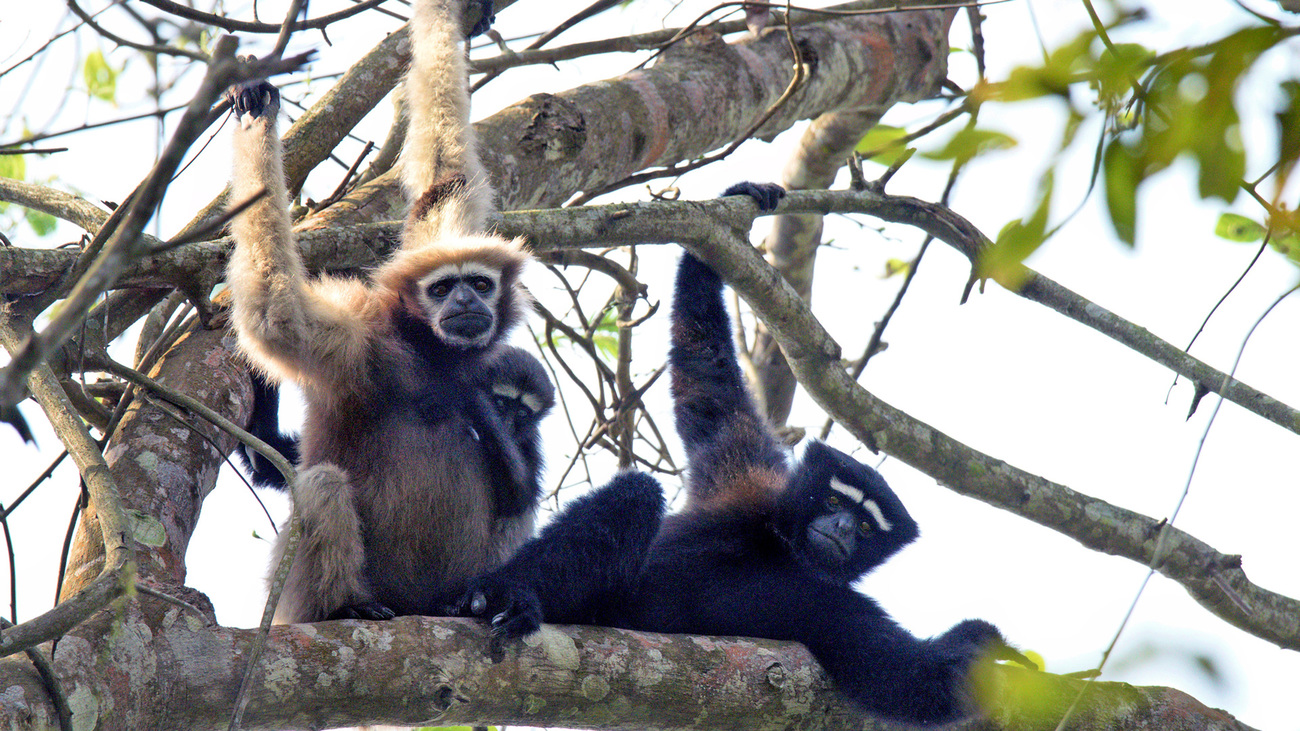
Hoolock gibbons comprise three species of primates in the gibbon family, native to Bangladesh, Northeast India, Myanmar, and Southwest China. Gibbons are apes—not monkeys—but they aren’t considered great apes, since they are smaller. The three species are the eastern hoolock gibbon (Hoolock leuconedys), western hoolock gibbon (Hoolock hoolock), and Skywalker hoolock gibbon (Hoolock tianxing)—which, yes, is named after the character from Star Wars. This is in part because the species’ scientific name translates as ‘heaven’s movement’, but also because the scientists who discovered the species in 2017 were fans of the franchise. It’s fitting, considering how these apes rarely spend any time on the ground, swinging from tree to tree. Sadly, the Skywalker hoolock gibbon and western hoolock gibbon are endangered, and the eastern hoolock gibbon is vulnerable.
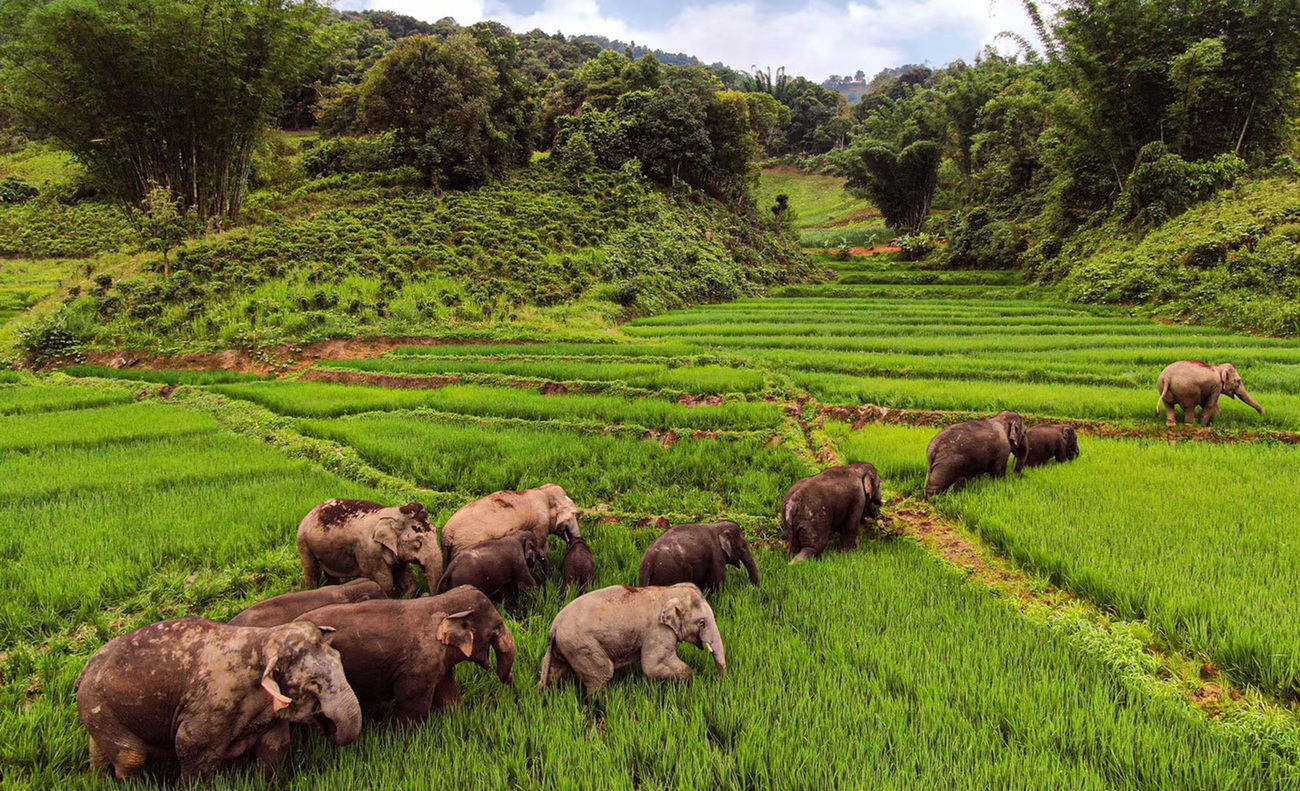
The Asian elephant (Elephas maximus) is the largest land mammal in Asia. Standing up to 3.5 metres (11.5 feet) tall, they are smaller than their African savannah elephant cousins similar in size to African forest elephants. Female adult Asian elephants weigh 3,000 to 4,000 kilograms (6,600 to 8,800 pounds), while male elephants can weigh up to 5,000 kilograms (11,000 pounds). While male Asian elephants typically live solitary lives, females are much more social and form groups in which age determines leadership.
As ecosystem engineers, Asian elephants are vital for maintaining biodiversity. Through their feeding behaviours, they disperse seeds, create clearings and trails, promote vegetation growth, and control the growth of certain plant species, which helps prevent wildfires. Unfortunately, Asian elephants are endangered.
6. Leopard cat
The leopard cat (Prionailurus bengalensis), also referred to as the mainland leopard cat, is a small wild cat native to South, Southeast, and East Asia. The leopard cat is about 45-75 centimetres (18-29 inches) long, with a 19-31-centimetre (7-12-inch) tail. It weighs only 1.7-7 kilograms (4-15 pounds), and it’s the most widespread small cat in Asia. They vary in colour—some leopard cats are pale tawny or yellow, while others are red or grey. Their coats have black rosette patterns, like a leopard’s, as well as solid spots on their legs and tails and stripes running from their foreheads to their shoulders. Leopard cats are primarily found in forests and jungles but also live in scrublands, semi-desert environments, and agricultural areas. They are primarily nocturnal. The IUCN classes leopard cats as least concern.
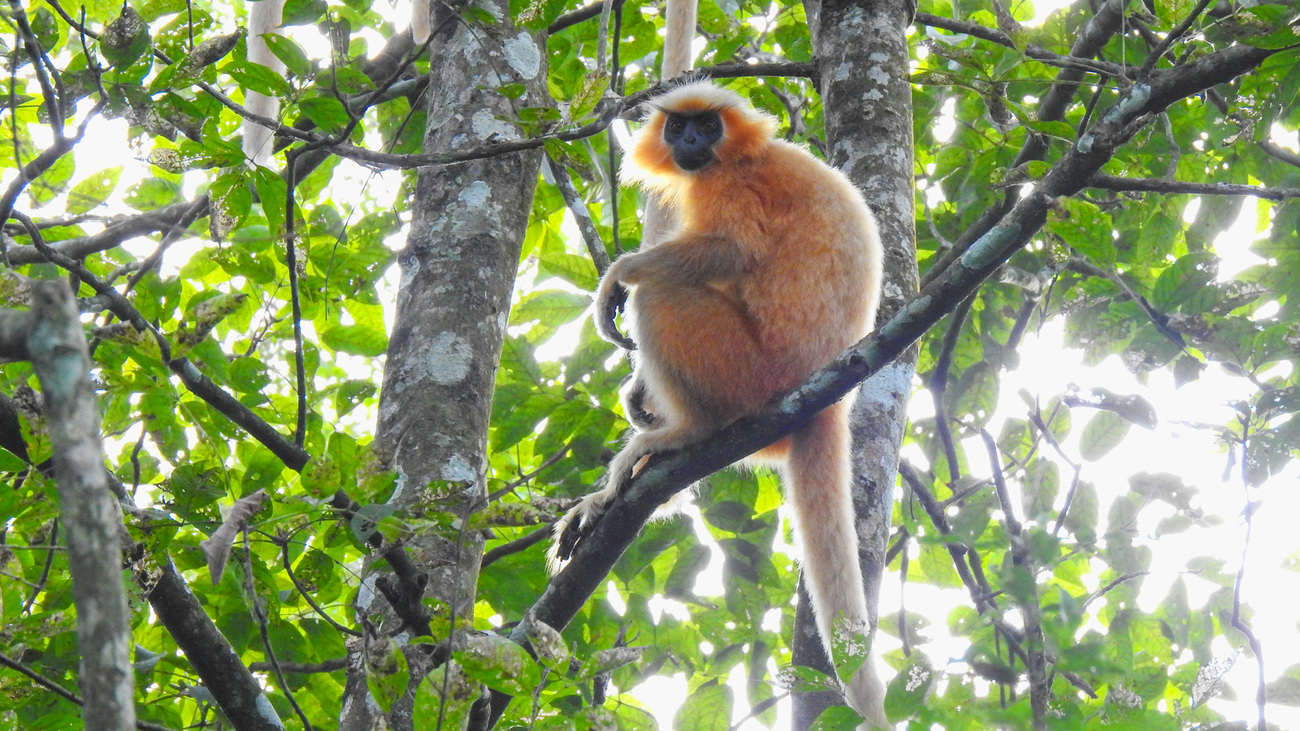
The golden langur (Trachypithecus geii), also known as Gee’s golden langur, is a monkey found in Western Assam, India and in the Black Mountains of Bhutan. This monkey species has a cream coloured or golden coat, which changes to a darker colour in the winter, and a black face. They have historically been considered sacred by many people living in the Himalayan region. Golden langurs are endangered.
Two subspecies of golden langurs have evolved thanks to a geological fault in the Himalayas—one lives in southern Bhutan and Assam, India, and the other lives further north in Bhutan. The northern subspecies has been known to breed with a different species, the capped langur, creating hybrids.
The great hornbill (Buceros bicornis) goes by many names, including the great Indian hornbill, great pied hornbill, and concave-casqued hornbill. It’s a large bird in the hornbill family, native to India and Southeast Asia, found as far south as the island of Sumatra. The great hornbill primarily eats fruit but may also feed on small mammals, reptiles, and other birds. It’s the official state bird of Kerala, India. The species is listed as vulnerable, and one of the biggest threats to great hornbills is deforestation.
The great hornbill is most easily recognised by the bright yellow and black structure that spans the top of its huge bill. This structure is known as a casque, and though it is hollow and serves no physiological purpose, it plays a role in mating, as male hornbills strike each other with their casques during flight. Hornbills are sometimes hunted for their casques and tail feathers, which are used for decorative purposes, and they are also sought for consumption.
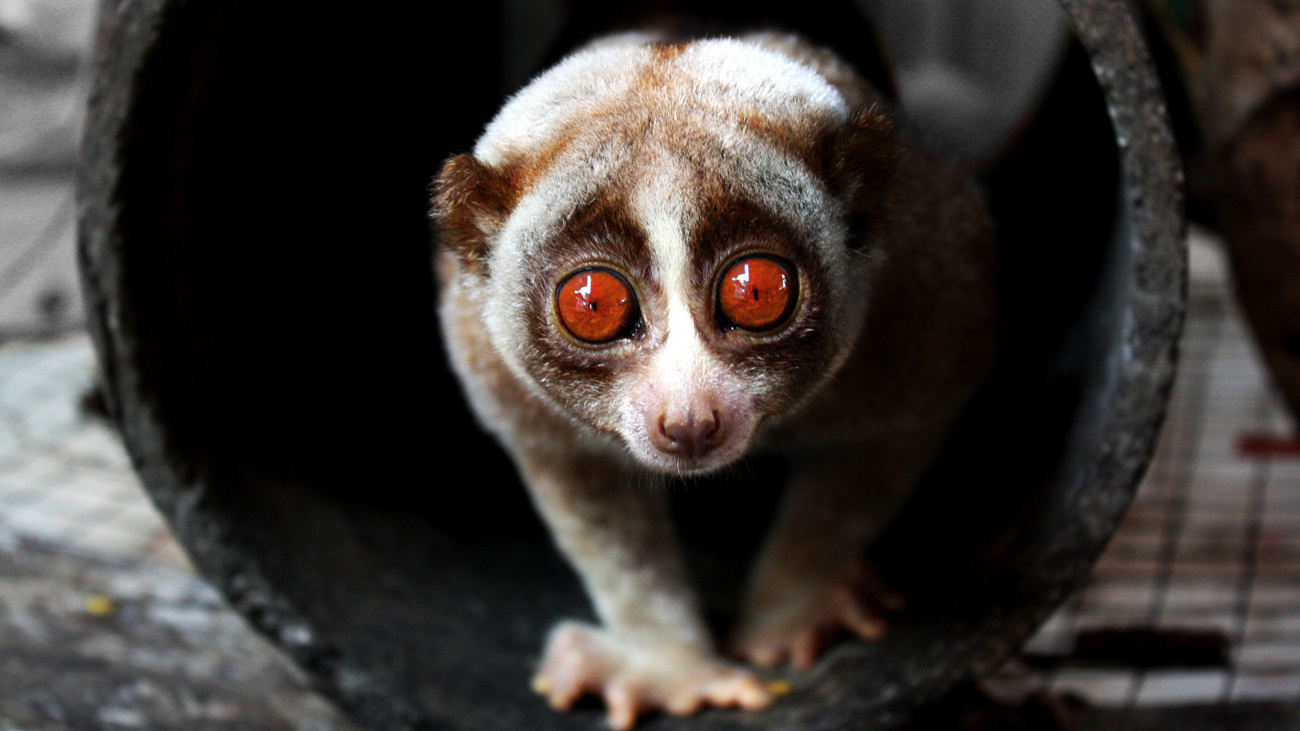
Slow lorises are a group of small, nocturnal primates in the genus Nycticebus, found in Southeast Asia, Bangladesh, India, the Philippines, and China. While they typically move slowly like sloths and remain still for hours at a time, they can also move fast enough to catch bugs and dodge predators. They are well-adapted to living in trees, with strong hands, flexible wrists, and extra vertebrae in their spine.
Slow lorises are the only known venomous primates, which places them amongst a small group of venomous mammals. They also have a unique defensive posture of raising their arms above their heads, which combines the fluid of their brachial glands with their saliva—then they deliver their venom, which is so powerful it can cause anaphylactic shock in humans.
Of the nine slow loris species classed by the IUCN, three are listed as vulnerable, four as endangered, and two as critically endangered.
The Indian star tortoise (Geochelone elegans) is a small tortoise with a beautifully geometric patterned yellow and black shell. It is native to parts of India, Pakistan, and Sri Lanka. Despite the brightness of the pattern to the human eye, it actually helps camouflage these tortoises against grass and vegetation.
Unfortunately, Indian star tortoises are victims of the exotic pet trade. They were the most frequently illegally traded tortoises seized in Thailand between 2008 and 2013. Agricultural equipment also has been known to harm many of these tortoises. The IUCN lists them as vulnerable.
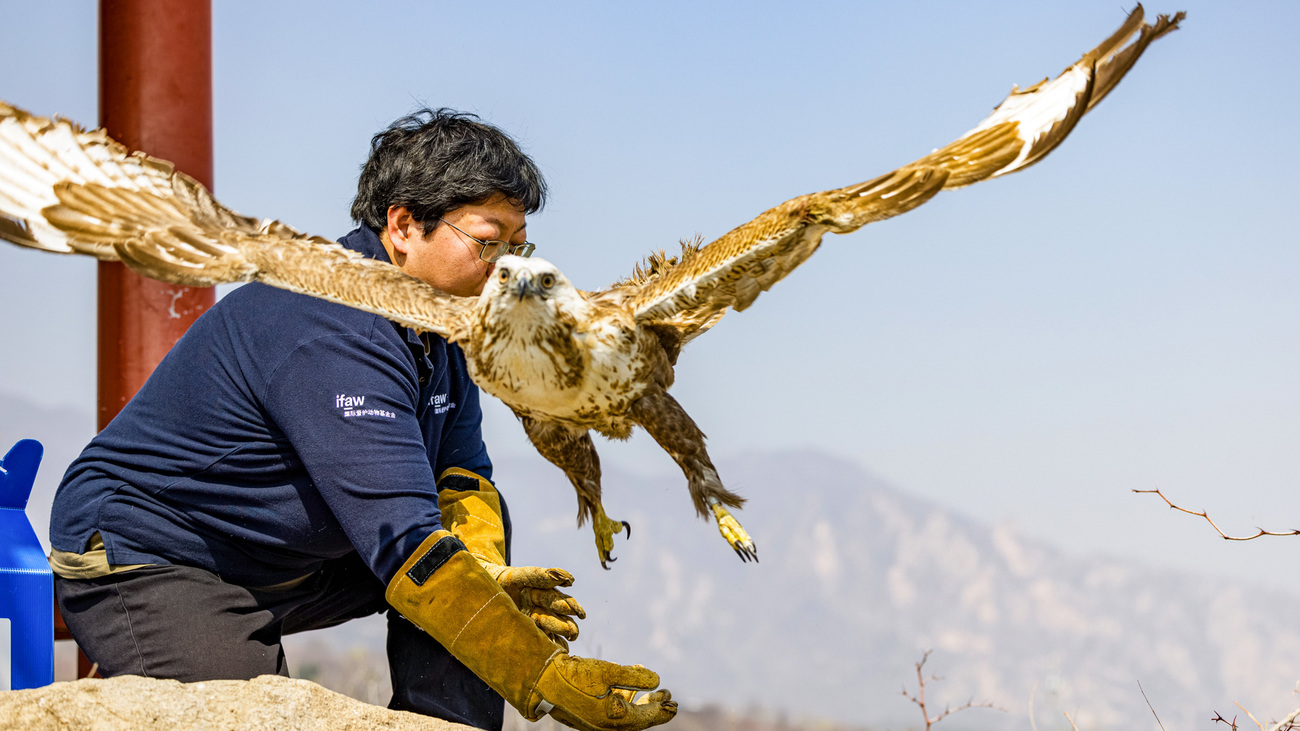
The upland buzzard (Buteo hemilasius) is a bird of prey that lives across Asia, from Kazakhstan to South Korea. Primarily inhabiting mountainous areas, plains at foothills, and grassland areas, the upland buzzard is a skilled hunter and has been observed eating the eggs of other birds. The species is listed as least concern, but habitat degradation may pose a threat, due to overgrazing of pastureland in certain areas of China, as well as risk of electrocution.
At IFAW’s Beijing Raptor Rescue Center (BRRC), more than 54% of the 5,800 raptors we have cared for have returned to the skies. One success story was a rehabilitated upland buzzard, which the team has been tracking since 2018. This bird has survived several breeding seasons in Mongolia.
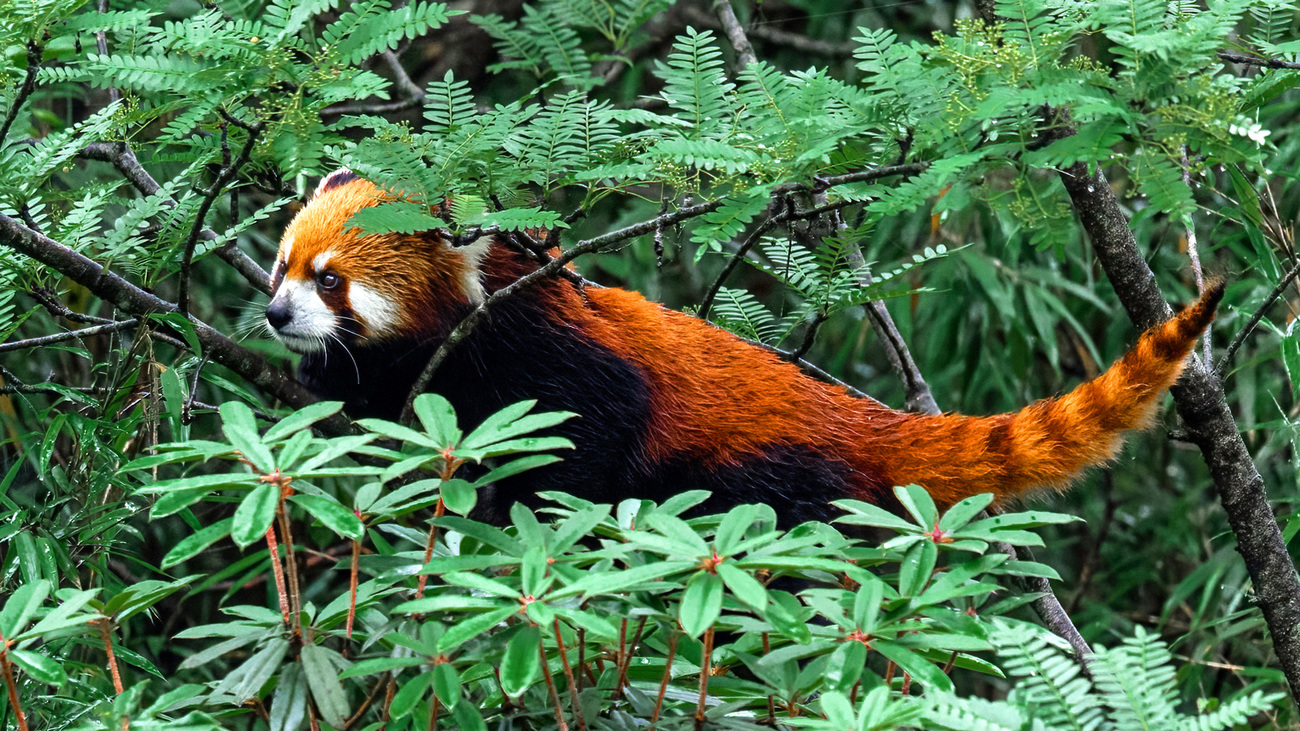
Also known as the lesser panda, the red panda (Ailurus fulgens) is much smaller than—and not closely related to—the giant panda. In fact, it’s the only surviving member of its family. Though the red panda is classified in the order Carnivora, placing it among the carnivorous mammals, it feeds mainly on bamboo shoots and leaves. Sometimes, they also eat acorns, fruit, roots, eggs, rodents, and small birds. The red panda’s range extends across a small region (mountain forests of the Himalayas and adjacent areas) encompassing parts of Bhutan, Nepal, India, Myanmar, and China.
A fun fact about the red panda is that it was known simply as the ‘panda’ for many years, before the giant panda (which is now more commonly known as ‘panda’) was formally described and named. Sadly, the red panda is endangered, threatened by habitat loss, fragmentation, and degradation.
The proboscis monkey (Nasalis larvatus), native to the island of Borneo, is known for its peculiar long nose. Males have much larger noses than females, and scientists speculate that their noses amplify the sound of their calls, which are intended to impress females and intimidate other males. They are also known as bekantan in Indonesian and orang belanda in Malay. They are some of the largest monkeys in Asia. Unfortunately, they are endangered, threatened by habitat destruction and hunting.
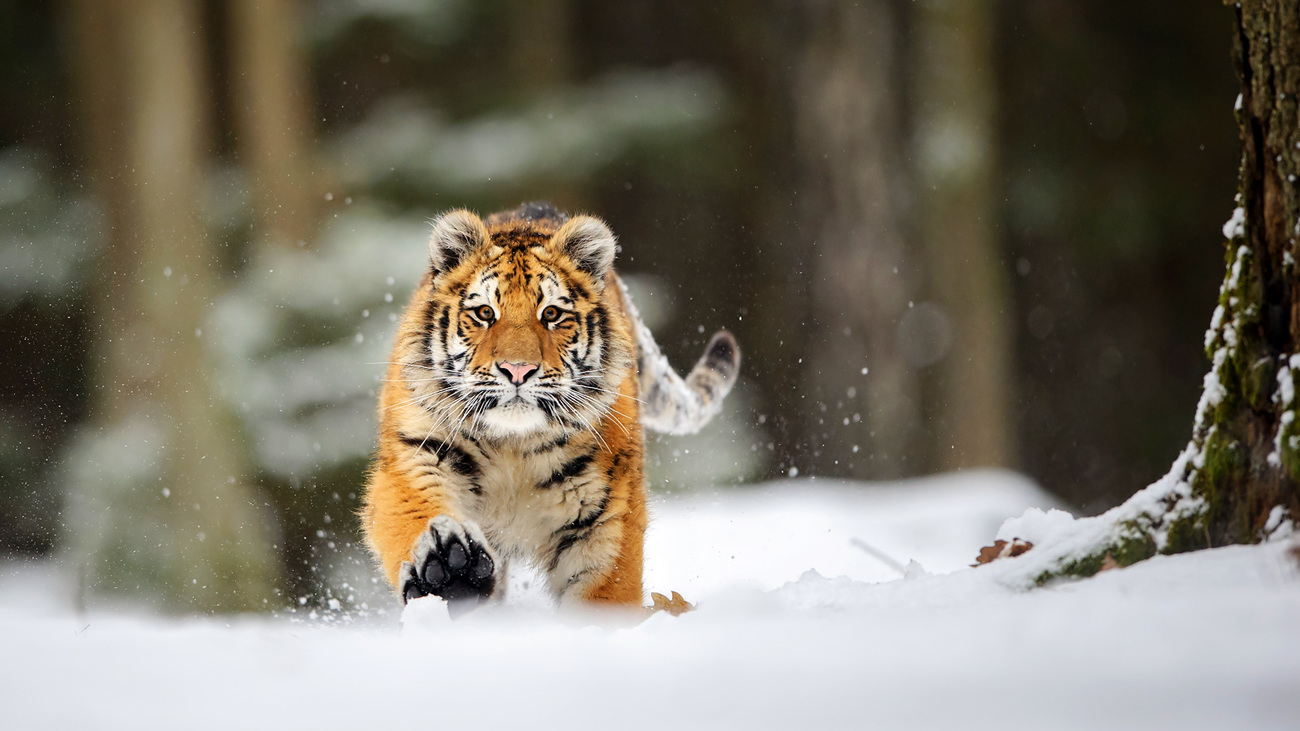
The Siberian tiger, also known as the Amur tiger or northeast China tiger, is a population of the Panthera tigris tigris subspecies that lives in Siberia and northeast China. This region presents a much harsher climate for tigers to live in than the habitats of other tiger populations, but it comes with the benefits of a decreased human presence and vast woodlands. Unfortunately, the tiger has gone extinct in much of its range, and the species as a whole is currently listed as endangered. Tigers are the largest big cats in the world. Siberian tigers, despite living in a region with low human population density, still experience poaching. Despite carrying a fearsome reputation, tigers generally avoid humans and will not attack them unprovoked. The Northeast China Tiger and Leopard National Park Administration and Russia's Land of the Leopard National Park signed a three-year work plan for tiger conservation in 2019, which was an important step in trans-boundary cooperation for both countries.
The dugong (Dugong dugon) is a marine mammal native to the Indian Ocean, the Red Sea, and parts of the west Pacific. Dugongs primarily inhabit coastal and inland waters, and they are closely related to manatees. Due to their herbivorous diet and slow, gentle nature, they are often called sea cows. Like cows, they graze on grasses as their primary food source. They are believed to have inspired the mythical tales of mermaids and sirens. Dugongs are classed as vulnerable. They are often victims of bycatch, vessel strikes, and illegal hunting. Habitat loss and climate change also threaten dugongs.
The Asian barred owlet (Glaucidium cuculoides) is a pygmy owl species native to Southeast Asia and the foothills of the Himalayas. It’s a small, brown owl with white stripes and bright yellow eyes. It is diurnal rather than nocturnal and can be seen hunting during the day.
The species is classed as least concern, but that doesn’t mean there are no Asian barred owlets facing danger. In March 2020, for instance, an owlet was found in a concrete water tank and rescued by the IFAW-Wildlife Trust of India (WTI) team, brought to the IFAW-WTI Center for Bear Rehabilitation and Conservation to dry off and keep warm. By the next morning, the owlet was ready to fly again.
The rusty-spotted cat (Prionailurus rubiginosus) is one of the smallest members of the cat family, Felidae. It lives in dense forests and rocky areas of India and Sri Lanka, and it is recognised by its short, reddish grey fur. It competes for the title of the world’s smallest cat at only 35-48 centimetres (13-19 inches) long, weighing 1-1.6 kilograms (2.2-3.5 pounds)—smaller than a domestic cat. Their eyes can be bright amber or green or a duller brown. The IUCN classes the rusty-spotted cat as near threatened, as it is experiencing habitat loss.
Hybrid breeding between rusty-spotted cats and feral domestic cats has been observed—but this does not mean that rusty-spotted cats make suitable pets. They aren’t domesticated and should only live in the wild.
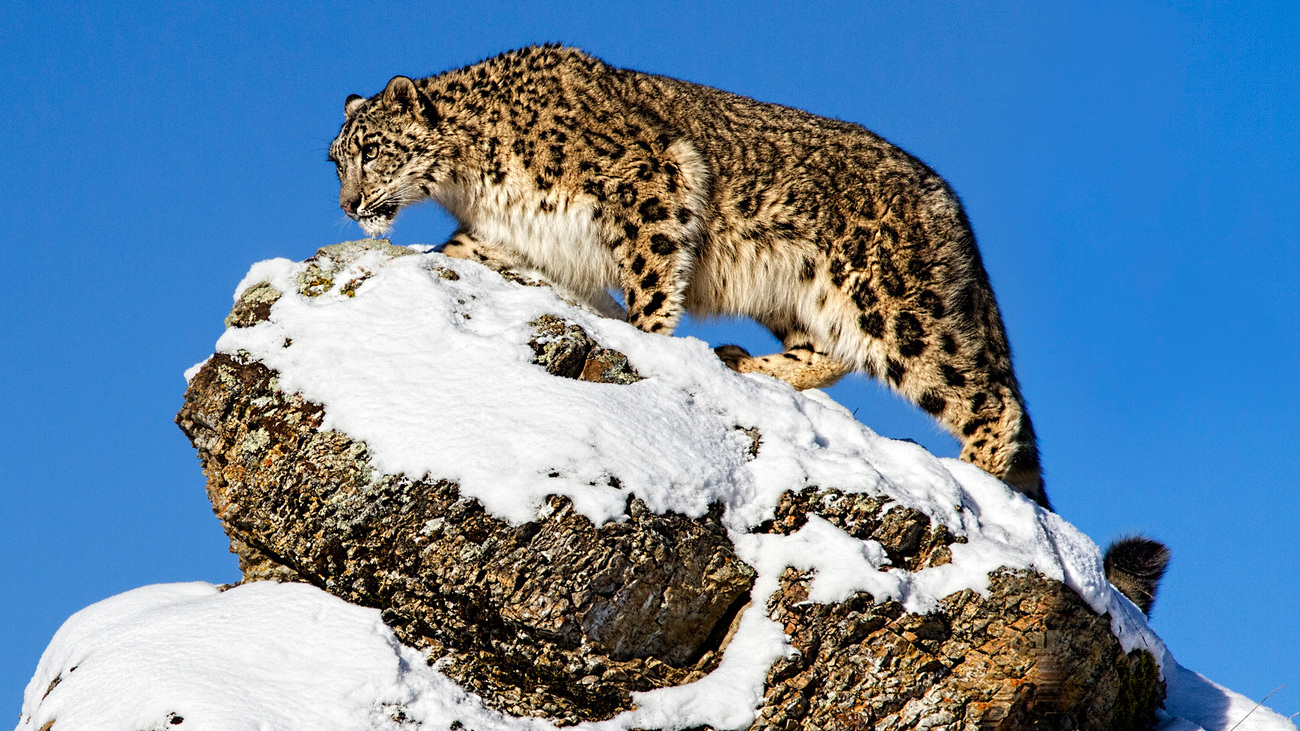
Native to the mountains of central Asia, the snow leopard (Panthera uncia)—also known as the ounce—experiences a cold, dry climate and inhabits cliffs, rocky outcrops, and ravines. They are solitary, elusive big cats. Interestingly, unlike other big cat species, snow leopards are unable to purr. The largest populations of snow leopards live in China and Mongolia. About 4,500 of the world’s 7,000 snow leopards live in China's Xinjiang, Xizang, Qinghai, Inner Mongolia, and four other provinces and regions. Snow leopards are stealthy hunters, using their powerful hind legs to pounce, and a single prey can provide them enough sustenance for two weeks. Snow leopards are listed as vulnerable.
Softshell turtles (the family Trionychidae) get their name from the fact that their shells lack hard scales—instead, they feel leathery and pliable. Primarily aquatic animals, softshell turtles also have unique faces with elongated, snorkel-like nostrils and long necks. While they don’t have gills, they can stay underwater for prolonged periods thanks to the structure and physiology of their mouths, which act similarly to the gills of a fish.
The softshell turtle family contains many species, more than half of which live in East and Southeast Asia. Some species are critically endangered, including the Yangtze giant softshell turtle, Asian narrow-headed softshell turtle, and Burmese narrow-headed softshell turtle.
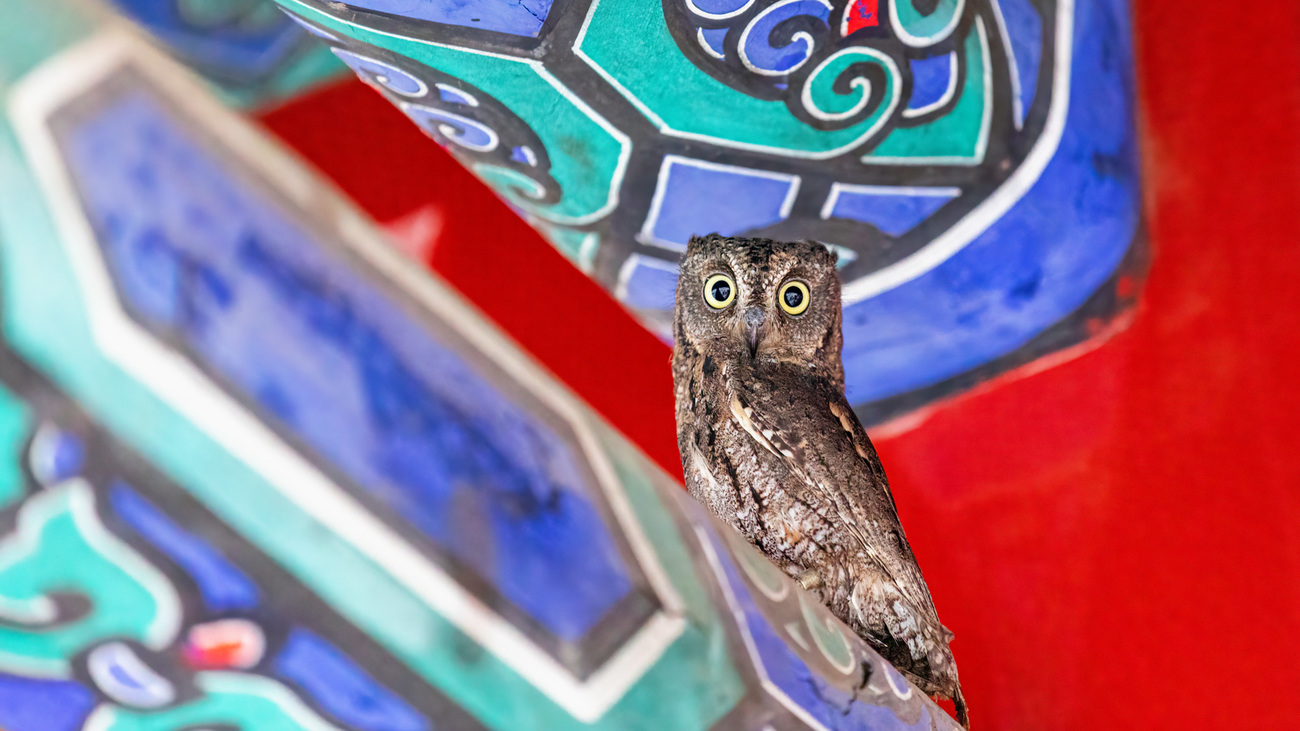
The oriental scops owl (Otus sunia) is a bird that lives in East, South, and Southeast Asia. It’s a brown owl with short tufts above its ears. Its call is heard as a series of three to four hollow-sounding notes, with the last two coming in rapid succession. Oriental scops owls usually live in the woods but can also be found in human-populated areas, including gardens and parks. The species is listed as least concern.
This summer, 19 orphaned oriental scops owls were admitted to IFAW’s Beijing Raptor Rescue Center. Because oriental scops owls can raise multiple chicks in the same breeding season, in rehabilitation, orphans can recover together and learn from each other. All of them have been released back to the wild during the autumn season as they grew up at BRRC.
Our work can’t get done without you. Please give what you can to help animals thrive.
Unfortunately, the browser you use is outdated and does not allow you to display the site correctly. Please install any of the modern browsers, for example:
Google Chrome Firefox Safari